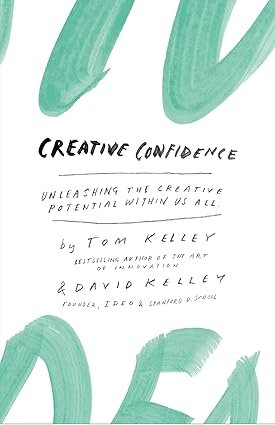1. Introduction of book review Creative Confidence

Creative Confidence: Unleashing the Creative Potential Within Us All by Tom Kelley and David Kelley is a motivational and insightful book about how everyone has the potential to be creative. It delves into the idea that creativity is not just reserved for artists or “creatives” but is something that anyone can unlock and apply to any field. The authors are renowned for their work in design and innovation, particularly through IDEO, the company they co-founded, and Stanford University’s d.school, where they promote design thinking.
Author’s Background: Tom and David Kelley are pioneers in innovation and creativity. Tom Kelley is the General Manager of IDEO, and David Kelley is the founder of the d.school at Stanford University. Their combined experiences in design, teaching, and innovation make them authoritative voices in the world of creative problem-solving.
Reader Engagement: Do you believe creativity is something we are born with, or can it be developed over time? Share your thoughts in the comments!
2. Why Should You Read This?
This book is worth reading for anyone who wants to break out of the limiting belief that creativity is not for them. It challenges conventional thinking by explaining how creativity can be nurtured and developed in any person, regardless of their background or profession. With practical advice and real-life examples, the book is relevant in today’s context where innovation and problem-solving are essential skills.
Contextual Relevance: In a world driven by constant change and innovation, this book provides a roadmap for building creative confidence. It’s highly relevant for entrepreneurs, professionals, students, and even those in non-creative fields who wish to bring more innovative thinking into their work. Compared to other books on creativity, Creative Confidence focuses heavily on practical application, making it accessible to a wider audience.
3. Key Teachings and Themes
The core message of Creative Confidence is that creativity is a mindset that can be cultivated. Some of the key teachings and themes include:
– Overcoming Fear of Failure: The Kelley brothers emphasize that fear is the biggest obstacle to unlocking creative potential. They discuss how reframing failure as a learning opportunity is crucial.
– Design Thinking: The book introduces design thinking, a problem-solving approach that encourages empathy, experimentation, and iteration.
– Creativity as a Process: Creativity isn’t a magical, one-time event; it’s a continuous process that can be honed over time.
Quotes and Passages:
One of the standout quotes from the book is, “Creative confidence is the belief that you can create change in the world around you and that the ability to make a difference is something all people have.”
4. How This Book Can Help You
Reading Creative Confidence can profoundly impact how you approach both your professional and personal life. It will help you:
– Think Creatively: The book provides strategies for overcoming mental blocks and generating innovative ideas.
– Gain Confidence: It encourages a mindset shift, helping readers believe in their creative abilities.
– Problem-Solving: By applying the principles of design thinking, readers can approach complex problems in new ways.
5. Writing Style and Structure
The authors adopt an engaging and accessible writing style that breaks down complex concepts into simple, actionable steps. The structure of the book alternates between personal anecdotes, case studies, and practical advice, which makes it not only inspiring but also very actionable. The use of real-world examples from IDEO and other organizations adds credibility and keeps the narrative engaging.
6. Criticism of the Book
While Creative Confidence is highly inspirational, some readers might feel that certain sections oversimplify the challenges of applying creative thinking in highly structured environments like corporations or government institutions. The focus is largely on positive success stories, and there is little discussion on deeper systemic barriers to creativity that exist in some organizations.
7. Why Summary Is Not Enough
Though summaries can provide a quick overview of the ideas in Creative Confidence, they don’t capture the nuanced personal stories and detailed examples that make the book impactful. It’s through these stories that the authors truly convey the importance of creative confidence, and readers would miss out on the depth of insight by relying on summaries alone.
8. Thought-Provoking Debates
Some of the criticisms and debates arising from this book include discussions around the feasibility of fostering creativity in every environment. Can creativity be instilled in highly structured, rigid industries? The book’s optimism opens up discussions on whether external factors (like company culture or societal norms) play a bigger role in limiting creativity than individual mindset alone.
9. Who Should Buy or Read This?
This book is for anyone who believes they lack creativity or feel constrained by societal definitions of creative roles. It is particularly beneficial for:
– Entrepreneurs, innovators, and business leaders looking to foster a more innovative culture.
– Professionals in any field who want to incorporate creative problem-solving into their work.
– Students and educators interested in the principles of design thinking.
– People looking to overcome the fear of failure and embrace experimentation.
Gift Option: This book makes an excellent gift for recent graduates, aspiring entrepreneurs, and anyone in a leadership role.
10. Reasons Not to Buy/Read
– Already Familiar with Creative Thinking: If you’ve already read similar content or have experience with design thinking, this book might not offer much new.
– Lack of Interest in Creativity: For readers who are more focused on rigid methodologies or not interested in creative processes, this book may not resonate.
– Not a Priority: If you’re not in a space where creativity is a high priority, you may not find immediate application for the book’s principles.
11. Conclusion
Creative Confidence is an empowering guide to unlocking your creative potential. Through practical advice, engaging stories, and actionable steps, the Kelley brothers show that creativity is not just the realm of artists and innovators but is available to everyone. The book’s emphasis on overcoming fear and building confidence in your ideas is invaluable in today’s fast-paced, ever-evolving world.
12. Final Recommendation
Creative Confidence is highly recommended for anyone looking to bring more innovation and creativity into their lives, whether in a professional or personal context. It’s an inspiring and practical read, full of insights that can help shift your mindset towards creative problem-solving.
Overall Rating: 4.6/5
Pros:
– Inspirational and motivating
– Practical strategies for building creative confidence
– Accessible writing style with engaging examples
Cons:
– Simplifies some of the challenges in fostering creativity in structured environments
Alternatives: If you’re looking for more in-depth techniques for creativity in specific areas, consider books like The War of Art by Steven Pressfield or The Creative Habit by Twyla Tharp. These books provide different perspectives on creativity and its role in personal and professional success.
A Family-Focused View from kutumbwarta.com
For readers who have reached this review through our partner site kutumbwarta.com, we appreciate your interest in learning more about this product. On kutumbwarta.com, our team writes in Marathi about important family-oriented topics, including parenting, financial planning, relationships, and health.
In a blog about a son sharing unspoken thoughts with his mother, we recommended the book Creative Potential Within Us All for its ability to inspire open communication and personal growth. This book serves as a practical tool for nurturing creativity and building stronger family bonds.
Here on awareandbeware.com, we provide an in-depth review to help you understand its features, benefits, and how it may suit your needs. If you haven’t yet, visit the blog – son wrote letter to his mother on kutumbwarta.com for valuable insights into how this book can contribute to a thoughtful and balanced family life.

